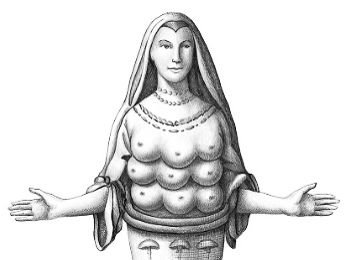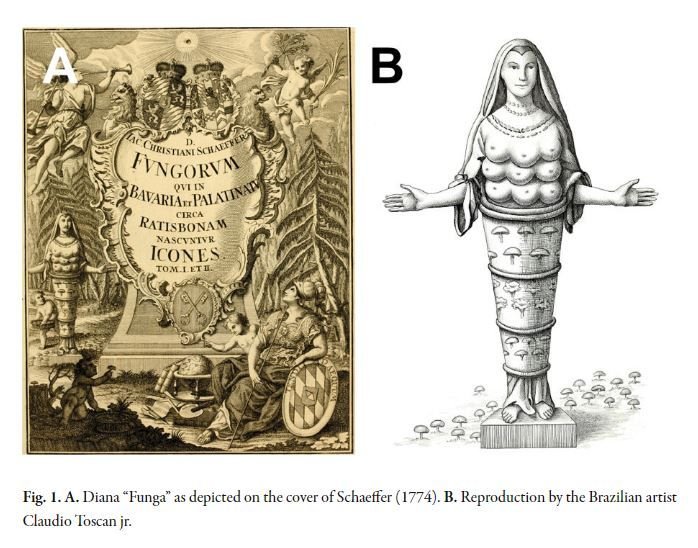Fantastic Funga: Why Language Matters
The vocabulary of mycology is one that reveals the way in which fungi have been traditionally treated in classification. Under old systems in which two kingdoms were recognized, plants and animals, fungi were assigned to the plants. The idea of fungi as plants is propagated in various ways. For example, we traditionally refer to the collection of fungi in a museum as an herbarium, when indeed they are not herbs.
And, when we learn about fungi and study them the terminology applied is often the vocabulary of botany. Furthermore, mycologists are often housed with botanists in academic departments. All of this leads fungi and fungal biologists being seen as to some extent on the margin rather than keepers of a kingdom of their own. How we use words and the words we choose to use can be powerful in correcting this marginalization.
Both plants and fungi do have spores but their functions and origins are different. In our walk through the woods we call out when we find fruitbodies but fungi do not have fruits in the same way apples do. I know we talk about mushrooms being like the apples on a tree but this is a shortcut for concepts about reproduction. Apples and mushrooms are not homologous structurally or developmentally. Hardly better are the terms ascocarp and basidiocarp since “-carp” as well refers to fruit via the Greek Karpos, meaning fruit. There are other examples in which we unconsciously force fungi into the plant kingdom.
The last decades have seen the separation of mycology from botany to the benefit of mycology. The study of the Kingdom needs to be recognized because the fungi vary so profoundly from plants – in their morphology, their genetics and their diversity. Fungi are distinctive and important in ecosystems both natural and human-made.
We argued (Kuhar et al. 2018) this point and pressed the need for a fungal-centric vocabulary. In particular we argued for the abandonment of the term flora in reference to the fungal communities. Flora has been the choice of terms for this notation in the historical literature but also in the present day. There are many examples of this application, -- The Fungus Flora of Venezuela and Adjacent Countries, The Fungus flora of the Soil, British Fungus Flora. Of course we know what is intended; the meaning is clear. But fungi are not plants; they are not part of the flora. The distinct position of the fungi is recognized these days in the nomenclatural code. The International Code of Botanical Nomenclature is now the International Code of Nomenclature for Algae, Fungi, and Plants., thus removing some of the historical baggage of fungi as plants and calling out the distinction.
We suggested that the term “Funga” be used instead of flora. Although certain to be rejected by spell check on your computer, it is a term that will unambiguously inform the reader of the content of the book, article or list. There are other words that have been used to express the same concept, such as mycoflora, mycobiota or mycota. Mycoflora is a Greek-Latin composition that was introduced as a substitute recognizing the problem of using flora for fungal communities. It informs but ambiguity remains. It is illogical to apply the term flora to treatments including fungi. For those versed in languages, the use of the term Mycoflora is also a source of confusion for teaching due to the linguistic non-correspondence of the roots of the word – Greek and Latin.
Mycota has been used to refer to what we are calling Funga. But this can be considered to be a taxonomic synonym of Fungi, the name of the kingdom, and has been used as such. It is confusing on that account and also because it recalls the use of mycota as a the suffix (such as in Ascomycota or Basidiomycota). In which case it indicates the rank of phylum. Finally, the term Mycobiota has also been applied to the fungal components of a community and can be considered a synonym of Funga. Although correct linguistically, we think that for educational and conservation purposes Funga is preferable and parallels the use of Fauna and Flora.
Funga provides a purely myco-based term and follows the pattern of recent years to eliminate plant-based terminology, as discussed above, and is in accord with the recommendation that fungarium be used for a collection of fungi rather than herbarium. Funga completes the trilogy of Funga, Flora and Fauna. The three Fs. Cato the elder said: “Grasp the subject, the words will follow.” It is time for the words to be clear and unambiguous.


